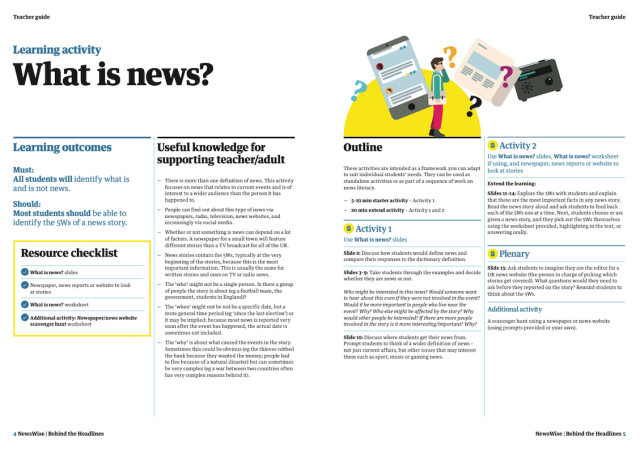

We have adapted our resources to provide a suite of cross - curricular media literacy resources for secondary SEND students with needs such as general and moderate learning difficulties, and social and communication interaction difficulties.
These activities and resources have been developed by a team of news and media literacy specialists, with extensive input and guidance from secondary SEND teachers.
They develop students’ critical literacy skills and awareness of how the media impacts their own behaviour, identity and wellbeing.
This suite of materials includes: lesson activities designed to be delivered in the classroom across a range of subject areas;
an interactive Fake or for real workshop (this workshop works well either as a way of kickstarting the sequence of activities, or as the culmination of the learning).
We have also developed media literacy training for SEND teachers to support the delivery of the workshop and activities in the classroom.
This project was made possible by funding from the DCMS.


We have adapted our Fake or for real workshop for secondary school students with special educational needs.
This workshop works well either as a way of kickstarting the sequence of activities, or as the culmination of the learning.
Students will discuss how they find out about news, analyse the different ways sources can be misleading and develop research and questioning skills, increasing their confidence in checking the trustworthiness of stories
Request the free resources and guidance for delivering this workshop in your classroom below.
These activities are designed to develop students’ media literacy skills using the context of news. The full sequence explores what news is, how and why news is produced, and why news is important, before moving on to looking at how to find trustworthy information and critically navigating news.
Download the full pack of activities at once, or pick from the individual activities below.

To help teachers use these resources in the classroom, we have developed a teacher guide. Every learning activity guide includes learning outcomes, a resource checklist, background information for the supporting teacher/ adult as well as explanations of the activities.
There are lots of definitions of news and people find out about the news from lots of different places.
Explore what news is, considering different audiences and purposes. Identify and explore the 5Ws of a news story.

The news we see goes through a selection process by editors or editorial teams.
Explore what makes a story newsworthy and assume the role of editor, choosing stories for their own news source.
An important role of journalism is holding power to account.
Explore what power means and how journalism can hold power to account. Explore the Windrush scandal reporting and consider the role of journalism in bringing about change in this and other stories.

Sometimes people deliberately make up news where they don't tell the truth, or only tell half of the truth - this is called fake news or misinformation. Fake news or misinformation is often shared on social media.
Understand what fake news is and what checks to make to decide whether a news report is real or fake. Explore and understand why fake news is harmful and how a fake news story might affect someone's emotions and behaviour.
When we go online, we enter a world where computers and companies are tracking what we are watching and reading. Companies can target that person with information they like and will therefore keep them on their website for longer.
Understand that websites can choose the news and information we see, and consider how to recognise online targeting. Explore why websites target information at users and why it's important to read information from different sources.

Journalists must not include their own opinions in a news report. They can include the opinions of those involved in the story but must not report them as fact. When a breaking news story happens, it can be difficult to know which information online is trustworthy because not many facts are known.
Understand the difference between fact and opinion and summarise a story using only the facts.
Every story has more than one side so can be told in different ways. Journalists need to make sure their reports are balanced by including different points of view, always representing both sides of the argument.
Identify the points of view included in examples of real news stories and which points of view are missing. Explore and understand why a news report should be balanced.

Some news reports might be slanted to make one side of the story seem more important. This is known as ‘bias’. A news report might be biased because it doesn’t include different viewpoints or because it influences the reader through the language used.
Explore and identify examples of biased reporting. Consider why a news report might be biased, and what might happen if people only read biased news reporting.

We would love to see examples of how these resources are being used, and hear your feedback on using the resources. Complete the form and to say thank you we'll send you a printed copy of the teacher guide.
You can also share your students’ learning and your comments with us via email: behindtheheadlines @theguardianfoundation.org
Visit our NewsWise and Behind the Headlines pages